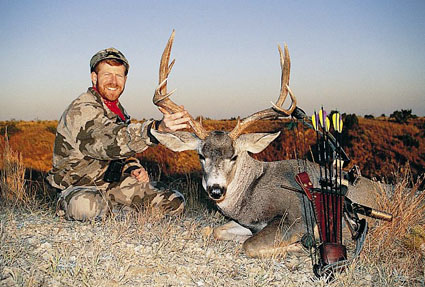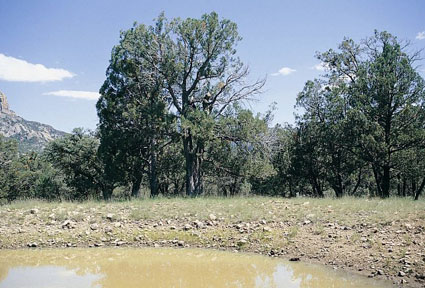<< Previously: Tactics For Farmland, Mountain Spot-and-Stalk, CRP Fields
Tactics For A Ground Blind Ambush
 The author pictured with a good buck he arrowed in October of 1999 from a well-placed ground blind. |
The blind wasn’t much to look at, but did it ever produce close-range encounters with mule deer bucks. Ultimately, I got a 20-yard shot at a mature buck that sauntered past the blind one too many times. I’m referring to a ground blind I used to ambush a fine 4x4 buck in October of 1999. I photographed the buck a couple of times early in the season, but late in the hunt I decided that maybe I’d made a mistake by passing the shot. Luckily, the buck gave me another chance and this time I left the camera at home.
The blind was nothing more than a simple stretch of camouflage netting, some cut broomweed and dead mesquite limbs set in a tight circle under the branches of a lone mesquite tree. Bucks passed out of a mesquite thicket and nearby canyon through the low spot in the fence and across a CRP field until they finally reached a distant crop. In situations where you see mule deer using a consistent travel path, whether it’s through a fence, across a saddle in the mountains, or on their way to agriculture, ground blinds can be awesome. I’ve seen dozens of bucks from the previously mentioned blind and year after year it remains a good place to hunt.
Treestands
For hunters from the East used to the climbs and long waits associated with waiting in trees for a shot at a whitetail, climbing into a treestand out West gives them a sense of comfort in their hunting method. Chris Cassidy of Alpine Outfitters in Colorado uses treestands on occasion to ambush big mule deer bucks along river bottoms and even in open country in the eastern section of the state. “We’ve had big muleys walk right down beaten trails in the river bottoms past stands set up for whitetail hunters. Even out in the prairie, if a specific buck routinely hangs out near a small patch of cover, a treestand in that location can be deadly,” says Cassidy.
Lots of time spent driving and glassing from trucks to pattern deer is important before selecting a stand site. You can’t be as picky about choosing a tree for a treestand in mule deer country as you can in dense thickets for whitetails. Pay attention to the wind direction and try to find a tree with some cover to keep you from being skylined. Stands placed in trees along corridors that deer travel to and from agriculture are especially effective. If a buck passes out of effective bow range don’t be afraid to try rattling or grunting to pull him in closer.
Thirsty Bucks
 Look closely and you’ll see a bowhunter in the cedar tree behind an Arizona waterhole. A great ambush! |
Water is a limited resource in desert terrain. Unlike high-country mule deer that enjoy numerous creeks and streams in the mountains, desert deer are always pinched on a place to quench their thirst. Hunting waterholes is especially deadly in arid regions like west Texas, southern New Mexico, and southern Arizona during early season when temperatures are hot and the ground may be brittle and cracked from a summer drought. However, waterholes are still effective on late-season hunts. While the temperatures might not drive the deer to water like they did earlier in the year, they still have to drink and because water is in limited supply you have a good chance of seeing deer. During late season December and January hunts, rutting bucks often follow hot does into water.
The older, bigger bucks tend to show up just before dark in my experience. That’s when I’ve seen the most deer around water, but friends in Arizona tell me they see lots of activity between the hours of 10 a.m. and 2 p.m. when other hunters are at home. Ground blinds of native vegetation, pit blinds, commercial blinds and even treestands can all work around water. Productive waterholes can be ponds near windmills, troughs intended for livestock, or simple puddles. Look for tracks around the water to determine how often the spot is used and glass from a distance to monitor a deer’s approach to the water. Set your blind or treestand on the downwind side of the water from where most of the deer approach. Today’s mule deer lives in a wide range of landscapes. From the tops of the Rocky Mountains to sage-covered flats and even into river bottoms and dusty deserts, big-eared bucks are at home in many different places.
While hanging a treestand might be a suitable tactic for whitetails 90 percent of the time, if you plan to consistently bag big muleys you’d better have multiple hunting strategies in your bag of tricks. Multiple tactics will make you a better hunter. And when you finally tag a wide-racked buck you can pat yourself on the back because you’ve just taken one of bowhunting’s toughest trophies.
Next: More Mule Deer Tips






